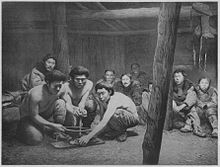Koryaks
 Koryak ceremony of starting the New Fire | |
| Total population | |
|---|---|
| 8,022 | |
| Regions with significant populations | |
Chukotko-Kamchatkan peoples | |

Koryaks (
The Koryaks are culturally similar to the
Neighbors of the Koryaks include the
The Koryak are typically split into two groups.[
According to the 2010 census, there were 7,953 Koryaks in Russia.
Etymology
The name Koryak was from the
Origin

The origin of the Koryak is unknown.
History

The Koryak once occupied a much larger area of the Russian Far East. Their overlapping borders extended to the Nivkh areas in
Under the
Culture

Families usually gathered into groups of six or seven, forming bands. The nominal chief had no predominating authority, and the groups relied on consensus to make decisions, resembling common small group egalitarianism.
The lives of the people in the interior revolved around
Today, the Koryaks also buy processed food, such as bread, cereal, and canned fish. They sell some reindeer each year for money, but can build up their herds due to the large population of reindeer.

The Koryak lived in domed shaped tents, called jajanga, or yaranga (from the more famous Chukchi term) similar to a
Transportation
This section includes a list of general references, but it lacks sufficient corresponding inline citations. (May 2013) |

The inland Koryak rode
They developed
Children learned to ride a reindeer, sleigh, and use snowshoes at a very young age.
The other Koryak were skilled seafarers hunting whales and other marine mammals.
Religion
Koryaks believe in a Supreme Being whom they call by various names: ŋajŋənen (Universe/World), ineɣitelʔən (Supervisor), ɣət͡ɕɣoletənvəlʔən (Master-of-the-Upper-World), ɣət͡ɕɣolʔən (One-on-High), etc. He is considered to reside in Heaven with his family and when he wishes to punish mankind for immoral acts, he falls asleep and thus leaves man vulnerable to unsuccessful hunting and other ills.
Environment

Koryak lands are mountains and volcanic, covered in mostly Arctic tundra. Coniferous trees lie near the southern regions along the coast of the Shelekhova Bay of the Sea of Okhotsk. The northern regions inland are much colder, where only various shrubs grow, but these are enough to sustain reindeer migration.[4] The mean temperature in winter is −13 °C (9 °F) while the short summers are +12 °C (54 °F). The area they covered before Russian colonization was 301,500 km² (116,410 mi²), roughly corresponding to the Koryak Okrug, of which the administrative centre is Palana.[5] Today the Koryak are the largest minority group with 8,743 people. The krai's population is now majority ethnic Russian, descendants of the Cossack colonizers.
See also
- Haplogroup G (mtDNA)
- Alyutors (Koryak sub group)
- Anapel
- Apuka District
- Olyutorsky District
References
- ^ Russian Census 2010: Population by ethnicity Archived 24 April 2012 at the Wayback Machine (in Russian)
- ^ [1] State statistics committee of Ukraine - National composition of population, 2001 census] (Ukrainian)
- Minority Rights Group. Retrieved 21 January 2024.
- ^ a b c d e f Chaussonnet 1995, p. 28-29.
- ^ a b c Kolga 2001, pp. 230–234.
- ^ Al'kor, Ia P., and A. K. Dranen. (1935) Kolonial'naia politika tsarizzna na Kamchatke, Leningrad: Tsentral'nyi istoricheskii arkhiv. Leningradskoe otdelenie.
- ^ a b Friedrich & Diamond 1994.
- ^ "Indigenous Peoples of the Russian North, Siberia and Far East", Arctic Network for the Support of the Indigenous Peoples of the Russian Arctic
- ^ Jochelson 1908.
- ^ King 2011.
- JSTOR 659272.
Works cited
- Chaussonnet, Valérie (1995). Crossroads Alaska: Native Cultures of Alaska and Siberia. Smithsonian, National Museum of Natural History. ISBN 978-1-56098-661-4. Retrieved 7 October 2020.
- Friedrich, Paul; Diamond, Norma (1994). Encyclopedia of World Cultures: Russia and Eurasia, China. Vol. 6. Boston, Massachusetts: G.K. Hall. ISBN 978-0-8161-1810-6. Retrieved 7 October 2020.
- Jochelson, Waldemar (1908). The Koryak, Memoirs of the American Museum of Natural History, vol. 10, parts 1–2: The Jesup North Pacific Expedition. Leiden: E. J. Brill.
- King, Alexander D. (2011). Living with Koryak Traditions: Playing with Culture in Siberia. Lincoln, Nebraska: U of Nebraska Press. ISBN 978-0-8032-3601-1. Retrieved 7 October 2020.
- Kolga, Margus (2001). The Red Book of the Peoples of the Russian Empire. Tallinn, Estonia: NGO Red Book. ISBN 978-9985-9369-2-4. Retrieved 7 October 2020.
- Gall, Timothy L. (1998) Worldmark Encyclopedia of Cultures and Daily Life: Koriaks. Detroit, Michigan: Gale Research Inc. ISBN 0-7876-0552-2
General references
- This article incorporates text from a publication now in the public domain: Chisholm, Hugh, ed. (1911). "Koryaks". Encyclopædia Britannica (11th ed.). Cambridge University Press.
Further reading
- Kennan, George (1871). Tent Life in Siberia: And Adventures Among the Koraks and Other Tribes in Kamtchatka and Northern Asia. Putnam.; "Über die Koriaken u. ihnen nähe verwandten Tchouktchen," in But. Acad. Sc. St. Petersburg, xii. 99.
- Jochelson, Waldemar. The Koryak. New York: AMS Press, 1975. ISBN 0-404-58106-4
- Jochelson, Vladimir Il'ich, and F. Boas. Religion and Myths of the Koryak Material Culture and Social Organization of the Koryak. New York: [s.n.], 1908.
- Nagayama, Yukari ed. The Magic Rope Koryak Folktale. Kyoto, Japan: ELPR, 2003.
External links
- Koryaks.net: Website about the Koryak people
- Transgender shamans
- . Encyclopædia Britannica (11th ed.). 1911.
